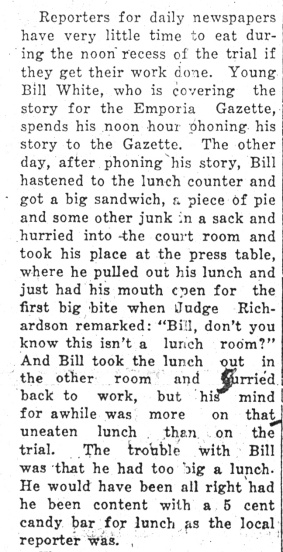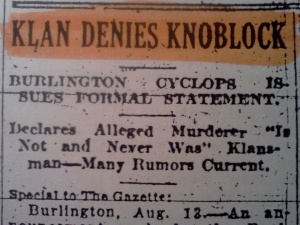I never would have known about the murder of Florence Knoblock if I hadn’t stumbled upon a folder of newspaper clippings at the library in 2007. Although radios were finding their way into homes during the 1920s–John Redmond even reports that a Day-Fan radio was installed in the jurors’ room in the basement of the Coffey County Courthouse–the newspaper was still the most common form of daily widespread communication.
As a both a reader and a researcher, I was really fortunate that most of the important newspaper articles were written by two extraordinary newspapermen: John Redmond of the Daily Republican in Burlington, Kansas, and William Lindsay White of the Emporia Gazette in Emporia, Kansas. Smart, funny, and extremely observant, both men vividly portrayed the events and people connected to the murder of Florence Knoblock in their own distinct writing styles.
John Redmond (1873-1953)

John Redmond, 1940. Photo courtesy of the Coffey County Historical Society and Museum.
A native of Burlington, Kansas, John Redmond had all but finished law school and was ready to sit for the bar exam when legendary newspaperman William Allen White (father of William Lindsay White) rerouted Redmond into a journalism career with the Emporia Gazette. Redmond would go on to work for the Topeka Daily Capital, the Wichita Star, and the Wichita Beacon before returning to Burlington in 1898 to buy a paper called the Jeffersonian for $400. During the next several years, numerous local papers would be acquired and merged together into the Daily Republican, whose masthead would first appear in 1921.
Redmond was an incredibly civic-minded man. During the Depression, he put a lot of energy into the Civilian Conservation Corps, which provided education and training to about 3,000 men during the years it was open. When Kansas began building reservoirs and enacting other flood prevention measures, Redmond championed Coffey County’s need for a reservoir, which would be named for Redmond after his death.
John Redmond’s writing style was a reflection of the man himself. His stories not only reported on the events of the day, but how the community responded to them. For example, in “Some Wierd [sic] Tales Being Circulated About Burlington,” which ran June 5, 1925, he reports on how other newspapers are portraying Burlington: “Burlington has been getting some very undesirable notoriety from the outside papers in connection with the brutal murder of Mrs. John Knoblock. Many wild and wierd [sic] stories have been published in them under a Burlington date line, and some have worked up stories of their one [sic]…” Similarly, in a June 11, 1925 article called “Another Tourist Wandering Around Brought to Jail,” he writes, “With the nerves of the people still on edge following the brutal murder of Mrs. John Knoblock on Decoration day, it is unhealthy for strangers to wander around much on the country roads or even in the towns.”

Reporters still run the Coffey County Republican out of the same building John Redmond built in the 1920s. His face is painted on a mural on the wall. Photo courtesy of Mark A. Petterson.
His writing could be compassionate, such as in the June 17, 1925 article “Mrs. John Mozingo Made Very Ill By Thoughtless Talk,” where he wrote, “Mrs. John Mozingo is quite ill from a nervous breakdown at her home west of Burlington, made so by the thoughtless people who have phoned or talked to her so much concerning the brutal murder of her daughter, Mrs. John Knoblock, and the efforts to find the murderer.”
Redmond could also be extremely funny. In the middle of a January 8, 1926 article listing all of the citizens subpoenaed to testify at John Knoblock’s first trial–an incredibly long list that goes on for several column inches–he throws in, “[George] Eaton’s dogs are not subpoenaed.”

John Redmond’s humorous quip in the middle of a long list of subpoenaed witnesses in the January 8, 1926 Dialy Republican.
William Lindsay White (1900-1973)

William Lindsay White.
A native of Emporia, Kansas, William Lindsay White was the son of the same William Allen White who rescued John Redmond from a career in law and set him on the path to journalism. White’s family home hosted people like Teddy Roosevelt, Herbert Hoover, and Douglas Fairbanks, and his father was known far and wide for his forward-thinking editorials.
Groomed to take over the paper some day, he would complete his degree at Harvard and would marry a New Yorker. When he returned to Emporia, he came back with a monocle, a walking stick, and a British accent–definitely NOT a typical Kansan and not nearly as well liked as his father.
However, W. L. “Bill” White was an extraordinary journalist. He served as a war correspondent during World War II, wrote several books, and took the reigns to the Emporia Gazette after his father’s death in 1944. He was very involved in politics and even served in the Kansas Legislature. He was not popular for some of his in-town causes, however; he argued that the beautiful second courthouse should be repaired instead of replaced, and he fought against the construction of the Civic Auditorium, which was, ironically, named in his honor.

The Emporia Gazette building in Emporia, Kansas. Photo courtesy of Cheryl Unruh.
Like John Redmond, Bill White was an excellent observer, and took the time to describe what people looked like as well as what they said and did. In the January 19, 1926 article, “Stand By Knoblock: Relatives Substantiate Defense Version,” he describes Florence Knoblock’s sister. “Mrs. Ella Kellerman, a sister of the murdered woman, then testified in Knoblock’s behalf. She is a pretty, young woman in her early thirties, whose hair is more of a reddish gold than yellow. ” He was also keenly aware of the atmosphere at both trials, and in “Accept Two Jurors,” an article that appeared on May 3, 1926, during the second trial, he wrote, “The general atmosphere of the trial seems to be different in Emporia. The attorneys are the same…the principals are the same and the judge is the same but some unknown something that seemed to hang over the Coffey county [sic] courtroom like a fog is missing today.”

Bill White’s description of John Mozingo ran in the January 19, 1926 Emporia Gazette.
Bill White did not feel the need to hold back out of respect for the feelings of others. He would write that Florence Knoblock’s father, John Mozingo, had a head shaped like a pear; he waxed poetic on attorney Owen Samuels’ comb over; and speculated on how much tobacco juice an autopsy would find in attorney W. C. Harris’ neck–all in a space of three paragraphs (January 19, 1926).
Covering the Murder, Investigation, and Trial
When Florence Knoblock was murdered, John Redmond and Bill White were at very different places in their careers. John Redmond had been running his own newspaper for 27 years. Just shy of his twenty-fifth birthday, Bill White’s career was just beginning.

Everyone in the courtroom was fair game. John Redmond tattles on Gazette reporter Bill White in the January 18, 1926 Daily Republican.
We know that John Redmond was recording the story from the very first moment word got out about the murder. He arrived at the Knoblock farm with County Attorney Ray Pierson and Dr. Albert Gray shortly after Sheriff Frank Hunter and Coroner J. O. Stone were called to the scene. Determining when Bill White began covering the story is a little trickier. We know the murder and investigation were being covered by the Emporia Gazette because of the newspaper articles, but because newspapers generally didn’t run bylines back then, we are only sure of Bill White’s presence when John Redmond mentions him in a Daily Republican article during the first trial.
The newspapers have two goals: report the news and sell newspapers. Because most people like to see themselves in the papers, newspaper reporters know that including as many names as possible is a great way to increase interest and sales. However, there is a caveat: you don’t want to irritate people into canceling their subscriptions. You don’t slam your own people. People outside your subscription area, though, are fair game. As a result, you almost have to read both the Daily Republican and the Emporia Gazette in order to get the complete picture. And because the two reporters report on each other, you get to know John Redmond and Bill White, who become part of their own stories.
Read more
William Lindsay White entry at the Kansas State Historical Society
Coffey County, Vol. 1 – A glimpse into its past, present and future!, compiled by Wanda Christy and published by Coffey County Today in 1987, is a good history of Coffey County with lots and lots of historic photographs.
William Lindsay White: 1900-1973: In the Shadow of His Father, by E. Jay Jernigan, University of Oklahoma Press, 1997.



















